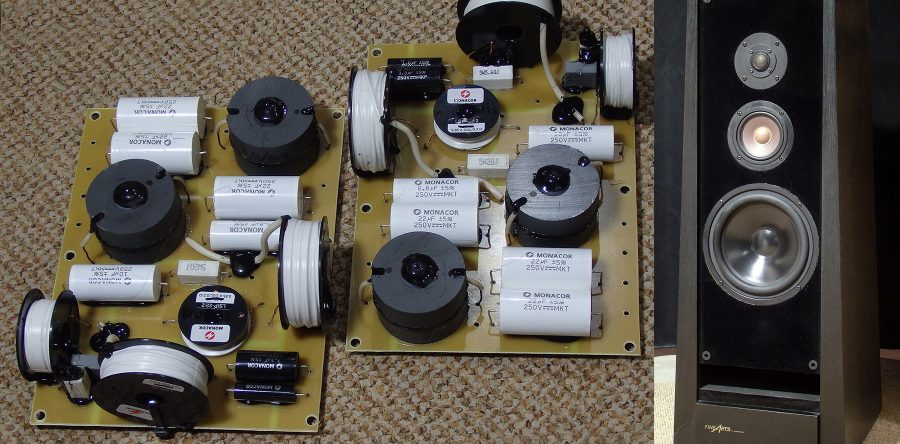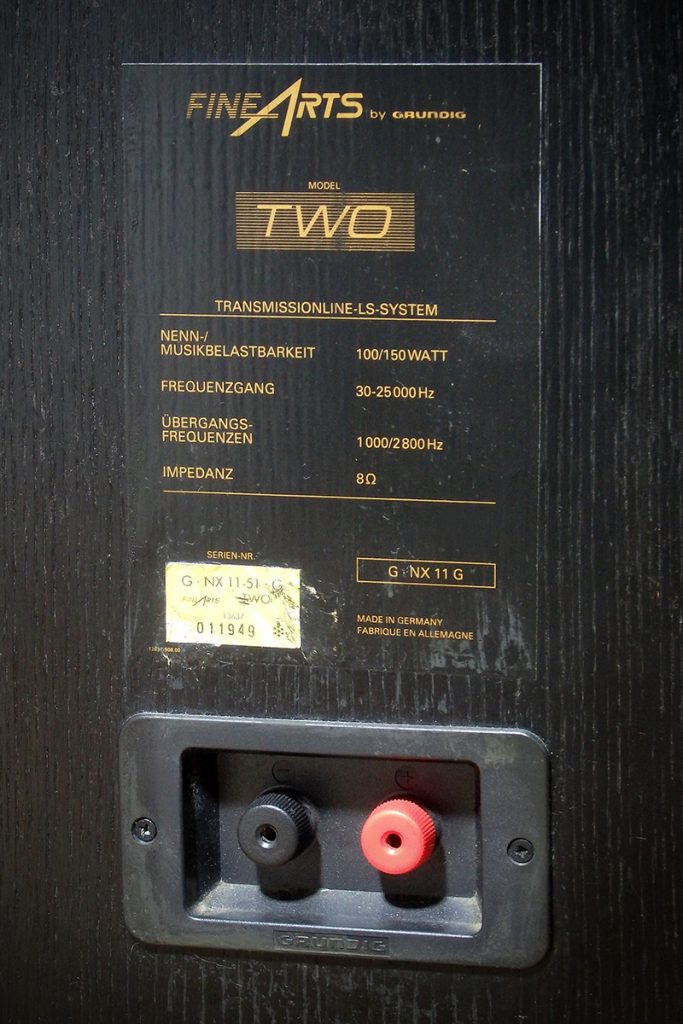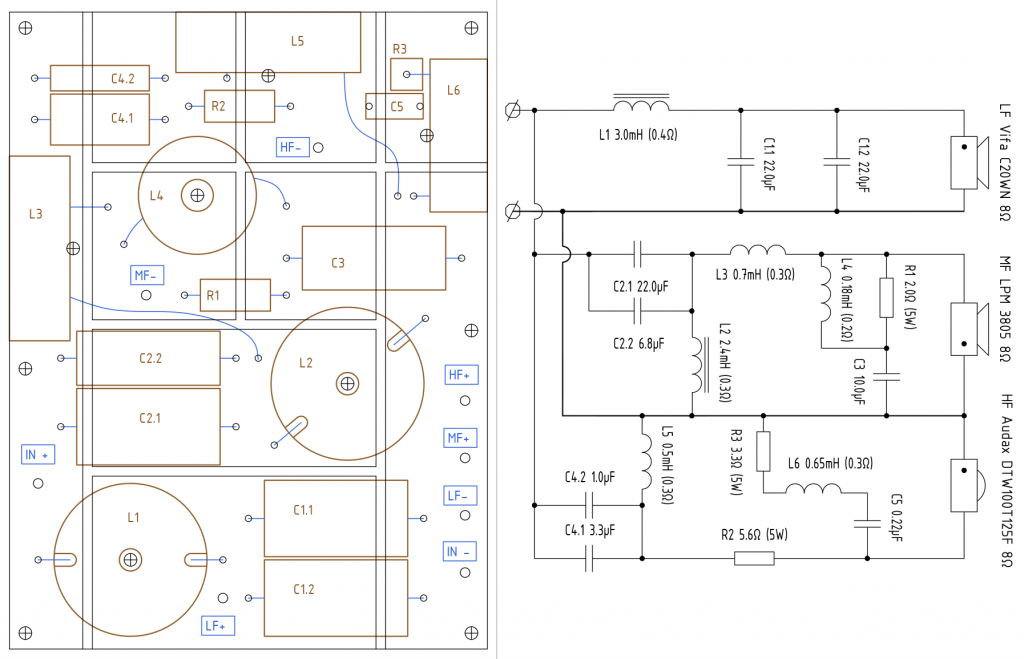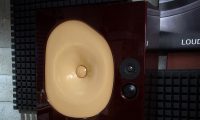Upgrade of vintage speaker systems by the German manufacturer Grundig
Construction
short description
3-way floor-standing speaker systems of small size in a housing with a “transmission line” resonator.
Drivers: 8″ Vifa woofer with paper cone, 4″ ITT/Nokia midrange also with paper cone and 1″ Audax tweeter with titanium dome.
Sounding
Subjective feelings and measurements of characteristics
In general, the sound makes a positive impression. Well balanced without significant timbral distortions. Unnatural high frequencies slightly spoil the overall picture. But in general, I liked the sound of these speakers.
Let’s see what the measurements of the characteristics of these speaker systems will show:
The frequency response measurements fully confirm the subjective impressions of the sound: the balance of low and medium frequencies is not bad. There is a slight unevenness in the upper middle frequencies (snake on the frequency response in the range of 1-5 kHz +/- 2dB), but it is not perceived by ear as a significant coloring of the sound. But the level of high frequencies is significantly overestimated and has a peak in the range of 12 – 14 kHz, which is the reason for the unnatural sound of high frequencies.
The factory crossovers have 1st order filters for the bass and midrange speakers and a 2nd order filter for the tweeter. This can be followed on the graph of the transfer functions of the filters.
The execution of crossover boards is frankly not very neat:
What other structural flaws did I pay attention to.
The transmission line looks more like a marketing ploy than a real advantage. In fact, it is a traditional bass reflex with a large area of the pertin and correspondingly increased efficiency. But the entrance of the port inside the case is tightly clogged with sound-absorbing material, which reduces its effectiveness to nothing! And nothing surprising, on the contrary – it is a correct solution to a pre-created problem, that is, the inappropriate use of this type of resonator, taking into account the TS parameters of the bass speaker.
Upgrade of crossovers
Fine tuning of filters, production of new crossover boards
In the new crossovers, I used a slightly different principle of constructing filter circuits than the Grundig engineers did. I will briefly explain what I was guided by when developing crossovers for these systems.
I’ll start with the woofer and cabinet.
The cabinet is not high, only 860 mm, the woofer is located close to the floor. In the factory setting of the filters, it emits a wide range of medium frequencies. Subjectively, this creates the effect that the sound is directed at the listener from below, somewhere from the floor. It is not natural. Of course, you can put the speakers on stands and raise them 20-30 cm above the floor, but the speakers were designed as floor speakers, besides, they have a sloping front panel that compensates for their small height.
To remove the “sound from the floor” effect, I gave the widest possible frequency band to the mid-range speaker. It picks up the bass driver from a frequency of 500 Hz. In factory crossovers, the separation between these drivers is organized at a frequency of about 1600 Hz, which is one and a half octaves higher.
I also applied 2nd order filters to provide sufficient filtering of the mids from the woofer and more attenuation of the lows from the midrange.
In the graphs of the transfer functions of the filters of the factory crossovers, insufficient filtering of low frequencies is clearly visible: a large peak at the resonant frequency (160 Hz) of the mid-frequency driver. This can lead to its overload and increase in nonlinear distortions.
In the medium-frequency filter, elements L4-R1 together with capacitor C3 form an elliptical filter that adjusts the frequency response of the medium-frequency driver in the range of 3-5 kHz.
In the schematic diagram of the crossover, you can also see the rejection circuit in the tweeter filter. This is not mandatory, but a desirable element in this case. Without it, the sound is slightly colored by a metallic cold shade at high frequencies. The rejection circuit removes the peak in the range of 12-14 kHz. In the off-axis frequency response plots, there is also a frequency response plot with the rejection circuit disabled. Factory crossovers, on the contrary, emphasized this peak of the high-frequency driver, and against the background of the general dominance of high frequencies, it looked even larger (see frequency response with original filters)
In addition to upgrading the crossovers, I would recommend slightly reducing the amount of sound absorbing material at the input of the resonator port to give it about +2dB back. This will make it possible to slightly expand the low frequency range, but without harming the overall frequency response. Do not fully open the port, this will lead to a strong dominance of the bass.
On completion
In my opinion, these speakers have good potential for good sound: good drivers, well-made cabinet. In general, a good sound in the basic version with factory crossovers. But I believe that the manufacturer still did not pay enough attention to the development and fine tuning of crossovers. With well-designed and fine-tuned crossovers, these speakers are capable of sounding much more interesting.
So if you own a “Fine Arts model two” and want to get better sound from these speakers, you can make new crossovers according to my schematics. But strictly follow the schematic diagram and the nominal values of the parts.
Or you can order ready-made crossover boards and install them in the speakers instead of the factory crossovers. You just need to connect them correctly, pay attention to the polarity of connecting the drivers.
The cost of manufacturing new crossovers for upgrading one pair of “Fine Arts model two” is 250 euros.



















